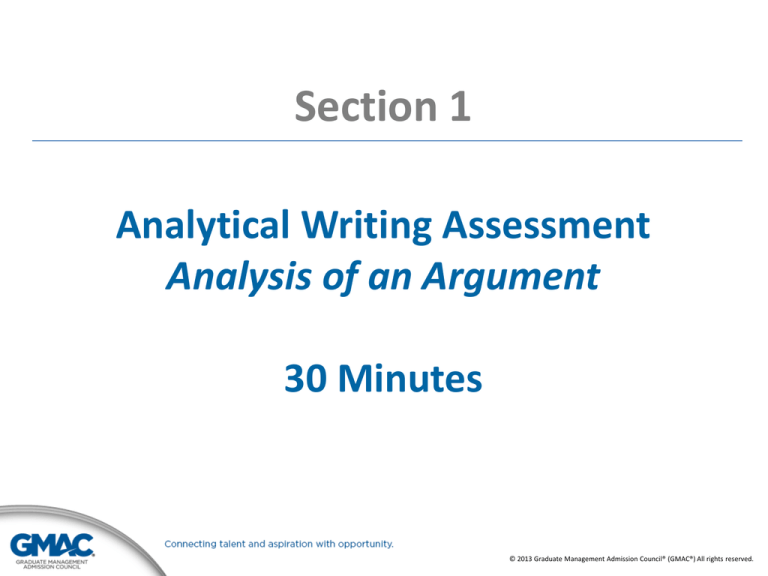
Section 1
Analytical Writing Assessment
Analysis of an Argument
30 Minutes
© 2013 Graduate Management Admission Council® (GMAC®) All rights reserved.
Good communication does not mean that you
have to speak in perfectly formed sentences and
paragraphs. It isn’t about slickness. Simple and
clear go a long way.
John Kotter
Professor of Leadership, Emeritus
Harvard Business School
© 2013 Graduate Management Admission Council® (GMAC®) All rights reserved.
Analytical Writing Assessment – Analysis of an Argument
Because occupancy rates for campus housing fell during the last
academic year, so did housing revenue. To solve the problem, campus
housing officials should reduce the number of available housing units,
thereby increasing the occupancy rates. Also, to keep students from
choosing to live off-campus, housing officials should lower the rents,
thereby increasing demand.
Discuss how well reasoned you find this argument. In your discussion be sure to
analyze the line of reasoning and use of evidence in the argument. For example,
you may need to consider what questionable assumptions underlie the thinking
and what alternative explanations or counterexamples might weaken the
conclusion. You can discuss what sort of evidence would strengthen or refute the
argument, what changes in the argument would make it more logically sound,
and what, if anything, would help you better evaluate its conclusion.
Sample
© 2013 Graduate Management Admission Council® (GMAC®) All rights reserved.
Section 2
Integrated Reasoning
30 Minutes
Currently Sacramento State Does not
use the Integrated Reasoning Scores
for Admission Decisions.
© 2013 Graduate Management Admission Council® (GMAC®) All rights reserved.
Today, mastery of business requires the
ability to filter and synthesize information
from multiple sources in order to make
effective business decisions.
Deans Paul Danos, Tuck School of Business and
David A. Pyke, University of San Diego School of
Business Administration
Poets and Quants, May 21, 2012
© 2013 Graduate Management Admission Council® (GMAC®) All rights reserved.
Integrated Reasoning:
Multi-Source Reasoning
Test takers are asked to use text,
charts, and/or tables from two to
three sources of information to
answer questions.
Sample
© 2013 Graduate Management Admission Council® (GMAC®) All rights reserved.
© 2012 Graduate Management Admission Council® (GMAC®) All rights reserved.
Integrated Reasoning:
Table Analysis
Test takers are presented with a
sortable table of information, which
has to be analyzed to determine if
answer statements are accurate.
Sample
© 2013 Graduate Management Admission Council® (GMAC®) All rights reserved.
© 2012 Graduate Management Admission Council® (GMAC®) All rights reserved.
Integrated Reasoning:
Graphics Interpretation
Test takers are asked to interpret a
graph or graphical image, and select
from a drop-down list to make
response statements accurate.
Sample
© 2013 Graduate Management Admission Council® (GMAC®) All rights reserved.
© 2012 Graduate Management Admission Council® (GMAC®) All rights reserved.
Integrated Reasoning:
Two-Part Analysis
A question will involve two components
for a solution. Possible answers will be
given in a table format with a column
for each component and rows with
possible options; test takers are asked
to consider the options provided.
Sample
© 2013 Graduate Management Admission Council® (GMAC®) All rights reserved.
© 2012 Graduate Management Admission Council® (GMAC®) All rights reserved.
Optional Break
Quantitative Reasoning
75 Minutes
© 2013 Graduate Management Admission Council® (GMAC®) All rights reserved.
"Measure twice, cut once."
Carpenter's Rule
© 2013 Graduate Management Admission Council® (GMAC®) All rights reserved.
Quantitative Reasoning – Problem Solving
The price of lunch for 15 people was $207.00, including a 15
percent gratuity for service.
What was the average price per person, EXCLUDING the gratuity?
A.
B.
C.
D.
E.
$11.73
$12.00
$13.80
$14.00
$15.87
Sample
© 2013 Graduate Management Admission Council® (GMAC®) All rights reserved.
Quantitative Reasoning – Data Sufficiency
In a certain class, one student is to be selected at random to read.
What is the probability that a boy will read?
1. Two-thirds of the students in the class are boys.
2. Ten of the students in the class are girls.
A.
B.
C.
D.
E.
Statement (1) ALONE is sufficient, but statement (2) alone is not sufficient.
Statement (2) ALONE is sufficient, but statement (1) is not sufficient.
BOTH statements TOGETHER are sufficient, but NEITHER statement ALONE is sufficient.
EACH statement ALONE is sufficient.
Statements (1) and (2) TOGETHER are not sufficient.
Sample
© 2013 Graduate Management Admission Council® (GMAC®) All rights reserved.
Optional Break
Verbal Reasoning
75 Minutes
© 2013 Graduate Management Admission Council® (GMAC®) All rights reserved.
In blog posts, on Facebook statuses, in emails, and on
company websites, your words are all you have. They are
a projection of you in your physical absence. And, for
better or worse, people judge you if you can’t tell the
difference between their, there, and they’re.
Kyle Wiens, CEO of iFixit
I Don’t Hire People Who Can’t Write
Harvard Business Review Blog Network
July 20, 2012
© 2013 Graduate Management Admission Council® (GMAC®) All rights reserved.
Verbal Reasoning – Reading Comprehension
In 1988 services moved ahead of manufacturing as the main
product of the United States economy. But what is meant by
“services”? Some economists define a service as something that is
produced and consumed simultaneously, for example, a haircut.
The broader, classical definition is that a service is an intangible
something that cannot be touched or stored. Yet electronic utilities
can store energy, and computer programmers save information
electronically. Thus, the classical definition is hard to sustain.
The author of the passage is primarily concerned with
A. discussing research data underlying several definitions
B. arguing for the adoption of a particular definition
C. exploring definitions of a concept
D. comparing the advantages of several definitions
The United States government’s definition is more practical:
services are the residual category that includes everything that is
not agriculture or industry. Under the definition, services include
activities as diverse as engineering and driving a bus. However,
besides lacking a strong conceptual framework, this definition fails
to recognize the distinction between service industries and service
occupations. It categorizes workers based on their company’s final
product rather than on the actual work the employees perform.
Thus, the many service workers employed by manufacturers –
bookkeepers or janitors, for example – would fall under the
industrial rather than the services category. Such ambiguities
reveal the arbitrariness of this definition and suggest that,
although practical for government purposes, it does not accurately
reflect the composition of the current United States economy.
E. clarifying some ambiguous definitions
Four additional questions...
Sample
© 2013 Graduate Management Admission Council® (GMAC®) All rights reserved.
Verbal Reasoning – Critical Reasoning
A city plans to attract new citizens with new housing and new facilities such as
parks, recreation centers, and libraries. One component of the city’s plan is to
require that developers seeking permission to build this new housing provide
these additional facilities at no cost to the city.
Which of the following, if true, would point to a possible flaw in the city’s plan?
A. Light, non-polluting industries have located in the area, offering more jobs and better paying jobs
than do the more-established industries in the area.
B. Other towns and cities nearby have yet to embark on any comparable plans to attract new citizens.
C. Most developers see the extra expense of providing municipal facilities as simply one of the many
costs of doing business.
D. Developers would pass along their costs to the buyer, thereby raising the cost of housing
units beyond the ability of likely purchasers to afford them.
E. Studies show that purchasers of new houses, especially first-time buyers, rank recreational
resources as an important factor in deciding to buy a particular house.
Sample
© 2013 Graduate Management Admission Council® (GMAC®) All rights reserved.
Verbal Reasoning – Sentence Correction
Carnivorous mammals can endure what would otherwise be
lethal levels of body heat because they have a heat-exchange
network which kept the brain from getting too hot.
A.
B.
C.
D.
E.
which kept
that keeps
which has kept
that has been keeping
having kept
Sample
© 2013 Graduate Management Admission Council® (GMAC®) All rights reserved.



